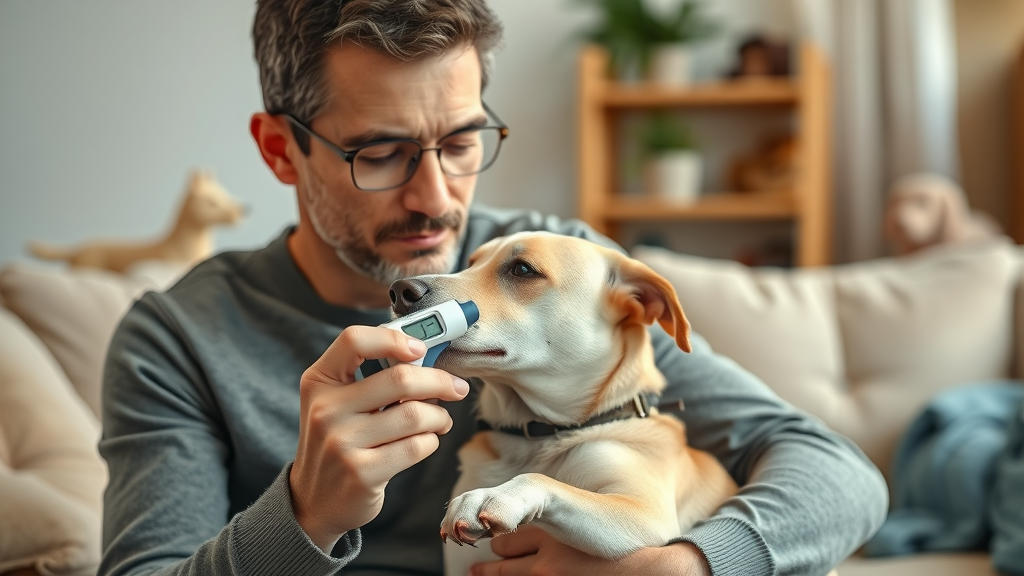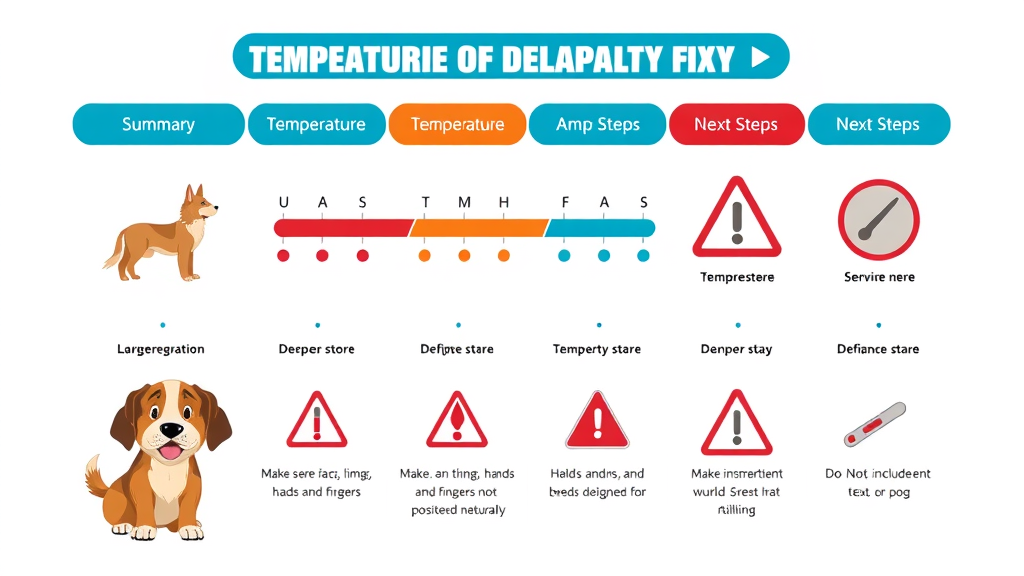Did you know that only 36% of pet owners can correctly identify fever symptoms in dogs ? This surprising statistic underlines a crucial fact: not knowing what is the normal temperature for a dog can put your pet’s health at serious risk. Dogs are experts at hiding the early signs of fever or illness, so understanding the right body temperature is key to spotting problems early and acting quickly to protect your furry friend.
Startling Facts: Why Knowing What is the Normal Temperature for a Dog is Critical
Did you know that dogs can mask early signs of fever, putting their health at risk? Recognizing abnormal body temperature could save your pet’s life.
Comprehensive understanding of what is the normal temperature for a dog prevents unnecessary panic and helps you act quickly in true emergencies.
Veterinary studies reveal that only 36% of pet owners can correctly identify fever symptoms in dogs.

What You Will Discover About What is the Normal Temperature for a Dog
How to measure your dog’s normal body temperature and when to suspect fever in dogs
Safe methods for checking what is the normal temperature for a dog
When to go to the vet if your dog has a fever or abnormal body temperature
Reliable guidelines for distinguishing natural body temperature range versus warning signs
Defining What is the Normal Temperature for a Dog: The Essential Guide
Understanding Normal Body Temperature and Temperature Range in Dogs
Normal body temperature for dogs typically falls between 101°F and 102.5°F (38.3°C to 39.2°C). Anything lower or higher can signal a health issue that needs attention. Most adult dogs and puppies share a similar baseline, but puppies might run slightly higher body temperatures as part of their development.
Normal temperature ranges for puppies may be at the higher end of the scale, while small dog breeds may cool faster than larger breeds. Always monitor temperature alongside signs of distress to get an accurate reading of your dog’s health.
"A dog's temperature range is crucial in identifying illness before symptoms progress. Regular monitoring goes a long way in prevention." — Licensed Veterinarian
Table: Dog Normal Body Temperature by Age and Breed Size
Ages |
Breed Size (Small/Medium/Large) |
Typical Temperature Range |
Deviations/Notes |
|---|---|---|---|
Puppy (0-6 months) |
All Sizes |
101.0–102.8°F (38.3–39.3°C) |
May run slightly higher during growth or stress |
Adult (6 months–7 years) |
Small |
101.0–102.5°F (38.3–39.2°C) |
Susceptible to rapid body temperature changes |
Adult (6 months–7 years) |
Medium/Large |
101.0–102.5°F (38.3–39.2°C) |
Temperature stable; high temperatures suggest fever in dogs |
Senior (7+ years) |
All Sizes |
100.5–102.5°F (38.1–39.2°C) |
May be slightly lower or higher based on medical conditions |

How to Measure What is the Normal Temperature for a Dog At Home
Using a Rectal Thermometer for Accurate Body Temperature Assessment
Always use a digital rectal thermometer for dogs, since it offers the most accurate reading. Lubricate the tip of the thermometer with petroleum jelly. Gently insert the thermometer about one inch into the dog’s rectum, then wait for the digital beep before removing it. Insert the thermometer slowly and keep your pet calm to avoid discomfort.
After use, clean the thermometer thoroughly with rubbing alcohol and soap. Wash your hands, and never share the thermometer with other pets or people. For safety, avoid glass thermometers, and handle your dog with care during the process to prevent stress or injury.

Can You Use a Human Thermometer? Safe Alternatives for Dog Fever Detection
While digital human thermometers work if used rectally , a pet-specific rectal thermometer is best for accuracy and hygiene. Ear thermometers are less reliable since the ear canal temperature may not reflect the core temperature as accurately. Digital thermometers designed for rectal use in pets are the preferred tool for routine checks.
Ear thermometer readings can be thrown off by ear infections or buildup. Glass thermometers are not recommended due to breakage risk. For a truly safe assessment, use a clean digital rectal thermometer and avoid inserting it too deeply.
Spotting Issues: Fever in Dogs and High Temperature Warning Signs
How to Detect When Your Dog Has a Fever: Key Symptoms and What to Do
Lethargy (tiredness and unwillingness to move)
Shivering or trembling
Loss of appetite
Red, glassy, or watery eyes
Hot ears or nose (warmer than usual when touched)
If your dog exhibits any of these signs, it’s essential to check its body temperature using a digital rectal thermometer or a reliable pet-specific model. Sometimes, fever in dogs is subtle, and the normal temperature range can be breached with only one or two mild signs. Always monitor for changes in behavior as those can be early indicators that your dog has a fever.

What is a High Temperature for Dogs? Normal Temperature vs. Fever in Dogs
If a temperature reading is above 103°F (39.4°C) , this signals a high temperature or fever in dogs. Persistent or rapidly rising temperatures put your pet at risk for complications such as dehydration, organ stress, or even heatstroke.
Causes of elevated body temperature can include bacterial or viral infection, hot weather, an ear infection , or reaction to medication. Be mindful—dogs with higher body temperatures require prompt action to avoid severe health outcomes or a trip to the vet.
What to Do if Your Dog Has an Abnormal Temperature
Immediate Actions: Caring for a Dog with a Fever at Home
Encourage your dog to drink plenty of cool water. Offer a cool, comfortable spot to rest away from direct sun or heat sources and use a fan or cool towel to cool your dog if needed. Do not give medication unless instructed by a veterinarian.
Signs such as difficulty breathing, collapse, persistent vomiting, or seizures are emergencies. Call your vet or seek veterinary care immediately if any of these appear. If unsure, err on the side of caution and get professional help fast.

When to Take Your Dog to the Vet for Abnormal Body Temperature
Contact your veterinarian if your dog’s temperature reading is above 103°F (39.4°C) or below 99°F (37.2°C), even if symptoms are mild. Persistent fevers or sudden drops in temperature can both be life-threatening if left untreated.
Share with your vet: recent temperature measurements, visible signs, appetite or energy changes, new medications, and possible exposures (like ticks, spoiled food, hot environments). Keeping a log can help your vet reach the right diagnosis faster.
-
What to tell your vet:
Exact temperature readings and method used (rectal thermometer/digital thermometer/human thermometer)
New or worsening symptoms (shivering, vomiting, collapse, etc.)
Recent exposures: walks in the heat, new food, potential toxins, injury history
Table: Summary of Dog Temperature Ranges and Action Steps
Temperature Above Normal |
Temperature Below Normal |
Immediate Steps |
When to Contact Vet |
|---|---|---|---|
Above 102.5°F (39.2°C) |
Below 100°F (37.8°C) |
Move to a cool environment, offer water, monitor constantly |
If temperature is above 103°F or below 99°F, especially with serious symptoms |
103–106°F (39.4–41.1°C): Fever range |
98–99°F (36.7–37.2°C): Hypothermia range |
Begin cooling or gentle warming measures, keep dog calm, avoid stress |
Contact vet if temperature stays too high/low after 30 minutes or symptoms worsen |
>106°F (41.1°C): Medical emergency |
<98°F (36.7°C): Medical emergency |
Transport to vet ASAP—risk of organ damage or collapse |
Always call or visit vet for emergency treatment |

FAQs: What is the Normal Temperature for a Dog?
How do you tell if a dog has a fever?
Watch for visible symptoms such as a hot nose or ears , red or glassy eyes, shivering, lethargy, and appetite loss. Always use a digital rectal thermometer for an accurate reading. If in doubt, call your vet for advice, particularly if your dog’s temperature is above 103°F.
Can I take a dog's temperature with a human thermometer?
Yes, but only if digital and used rectally —never orally or armpit, as this can give false readings. Pet-specific thermometers are more reliable. Dispose of or clean it thoroughly after each use.
What is a sick dog's temperature?
A fever in dogs is usually present when temperature is over 103°F (39.4°C) . Hypothermia is diagnosed below 99°F (37.2°C) . Both require a vet’s attention for proper treatment and diagnosis.
At what temperature should I worry about my dog?
Any temperature reading above 103°F or below 99°F is abnormal. If there are obvious symptoms like collapse, labored breathing, or seizures, take immediate action and consult your vet urgently.
Quick Reference List: Safe Practices to Monitor Dog Body Temperature
Monitor temperature regularly if your dog is unwell
Use a dedicated digital thermometer for your pet
Avoid mercury glass thermometers for safety
Know your dog’s normal temperature range (see table above)
Never hesitate to contact your veterinary care provider if uncertain
Key Points on What is the Normal Temperature for a Dog Every Pet Owner Should Remember
Recognizing abnormal body temperature saves lives
Rectal thermometers offer the best accuracy
Fever in dogs is not always obvious
Contact a vet for anything outside the 101°F–102.5°F range
Vet-Recommended Resources and Further Reading
Consult official veterinary health sources like the American Veterinary Medical Association (AVMA) and trusted websites such as PetMD for ongoing education.
Books on canine health can help you understand breed-specific issues related to normal body temperature.
Stay connected with your veterinarian for up-to-date advice and resources to keep your dog healthy.
Newsletter Signup: Stay Informed, Keep Your Dog Healthy
Want expert advice, trending products, and must-know health tips for your pet? 📬 Join our free monthly newsletter — made for pet lovers, by pet lovers.
Final Thoughts: What is the Normal Temperature for a Dog and When Extra Care is Essential
"Proactive pet health starts by understanding what is the normal temperature for a dog. Prevention and early detection truly make a difference." — Board-Certified Veterinarian
Understanding your dog’s normal body temperature is crucial for monitoring their health. The normal body temperature for dogs typically ranges between 101°F and 102.5°F (38.3°C to 39.2°C). Temperatures above or below this range may indicate health issues that require attention.
To accurately measure your dog’s temperature, it’s recommended to use a digital rectal thermometer. Lubricate the tip with petroleum jelly, gently insert it about one inch into the dog’s rectum, and wait for the digital beep before removing it. This method provides the most reliable reading of your dog’s core temperature.
If your dog’s temperature exceeds 103°F (39.4°C) or falls below 99°F (37.2°C), it’s advisable to consult your veterinarian promptly. Persistent fevers or sudden drops in temperature can be life-threatening if left untreated. Monitoring your dog’s temperature alongside other signs of distress can help you detect potential health issues early and seek appropriate care.
 Add Row
Add Row  Add
Add 




Write A Comment